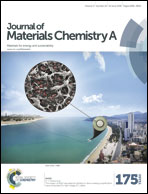Novel FeNi2S4/TMD-based ternary composites for supercapacitor applications†
Abstract
Ternary electrode materials based on graphene, FeNi2S4, and transition metal dichalcogenides (TMDs) were obtained via a one-pot synthesis method. Compared to binary materials, FeNi2S4–graphene (g)–2D-TMD nanocomposites exhibited better performance, which is a direct consequence of their unique ternary structures and the induced synergistic effect among their three components—ultrathin TMD nanosheets, highly conductive graphene networks, and FeNi2S4 nanoparticles. With the fabricated materials, we constructed electrodes to assess the electrochemical performance. The results are promising: the materials exhibited rapid electron and ion transport rates and large electroactive surface areas, testifying to their excellent electrochemical properties. In particular, the FeNi2S4–g–MoSe2 electrode demonstrated a maximum specific capacitance of 1700 F g−1 at a current density of 2 A g−1 (8.5 F cm−2 at a current density of 10 mA cm−2) and a capacitance retention of approximately 106% after 4000 cycles at a charge–discharge current density of 2 A g−1. These electrochemical results indicate that the ternary composite, FeNi2S4–g–MoSe2, is a promising candidate electrode material for high-performance supercapacitors.


 Please wait while we load your content...
Please wait while we load your content...